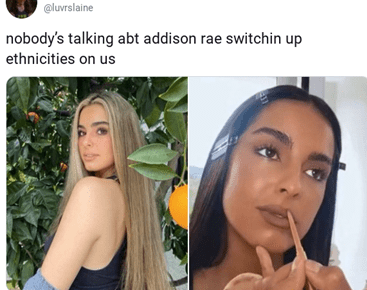
In 2020, TikTok became the most downloaded app worldwide (Bellan, 2020). Because the social media platform allows users to easily create and share short videos on any topic, anyone and everyone can feel at home on the app. From vegan pumpkin bread recipes to WAP dance tutorials, millions of young people have turned to TikTok for entertainment and social interaction during a time during the increased isolation brought on by the pandemic. Moreover, since the app has rapidly increased in use, it is not only used a way to cure boredom but as a way to attain fame for ambitious young content creators. Indeed, with the help of TikTok’s sophisticated algorithm that caters content to each individual’s unique interests based on their likes and activity patterns, users do not need to be celebrities in order to gain a large following and attain influencer status. For example, 20-year-old dancer/lip-syncer Addison Rae is the third-most followed person on the app with over 81 million followers – about 23 million more than world-renowned actor Will Smith (Talbot, 2020 and Insiflow, 2021). And because of this popularity, Rae and TikTok’s other top influencers (all 20 or younger) are making millions of dollars from their daily content.
Despite the fame, recognition, and massive audiences these young people have garnered, recent scandals among the TikTok elite have left some wondering whether the influencers are using their platforms ethically. One controversy involving Rae (as well as several other TikTok influencers) revolved around what some viewed as her lack of commitment to racial justice. As the Black Lives Matter movement gained traction on various social media sites after the murder of George Floyd, influencers from Instagram and YouTube used their platforms to voice support for the movement and spread information regarding nation-wide actions their followers could participate in to protest police violence against Black Americans. Yet, the top TikTok stars fell silent, and were subsequently criticized for their failure to contribute to the cause (Allyn, 2020). Additionally, Rae has faced backlash for retweeting an All Lives Matter post from a few years ago, as well as “blackfishing” – altering an image to appear darker in skin color – in some of her social media photos (Gesualdi-Gilmore, 2020). Social media can easily be used for aesthetic creativity and free expression, but such uses of race and ethnicity can also illicit criticisms about one’s ethics in using their influence. More recently, Bryce Hall – another top TikTok influencer and Rae’s former boyfriend – faced not only public disapproval but legal charges after hosting a large birthday party in Los Angeles with over 100 maskless attendees during the height of the COVID-19 pandemic (Tenbarge, 2020). Because these highly-paid influencers are afforded a huge audience on TikTok, some believe that they should exercise greater responsibility to be role models for their (mostly teen) followers – and if they don’t, they should be cancelled.
Conversely, others have argued that criticisms of these influencers are overstated because gaining fame on the app is inherently messy. Like any other social media platform where anyone is free to create an account and share content, competition for viewership is extremely steep. While one may assume that attention must be positive in order for someone to cultivate a popular image and achieve influencer status, media psychologist Pamela Rutledge notes that “attention instinctively comes from anything that’s unusual or highly emotional” so “creators are more or less guaranteed attention and interest from their fans” when drama exists because “with intrigue comes more clicks, views, revenue, and brand deals” (Dodgson, 2019). Thus, if nothing spreads faster online than disapproval, courting controversy is simply part of making it as an influencer. Moreover, the creator-centric model of TikTok means that it allows for various forms of expression and creativity. With so many users creating content daily, some of it is bound to run afoul of viewer expectations, so we cannot expect these influencers to always do or say what we would like – Why should they be cancelled for that? Especially since posts from a distant time or a different context can easily be dredged up into the present, some think it is overly harsh to hold these young adults to such a high standard. Ultimately, while some of them may have purposely sought fame on the app, it is unlikely that any of them strove to be viewed as exemplars, mentors, or authorities for young audiences, so why should they have to take on a responsibility they never asked for?
Despite the controversies surrounding many of TikTok’s biggest stars, there are also plenty of other users who manage to avoid scandal altogether. While they may not be as popular as the elite, these accounts have garnered followings large enough to nonetheless be considered influencers in their own right. For example, Tabitha Brown has earned the admiration of over 4 million followers by simply sharing vegan recipes, virtual hugs, and messages of self-care and compassion (Shapiro, 2020). One user commented on one of her videos: “You have honestly gotten me through this pandemic! So grateful that you exist.” Clearly then, whether TikTok influencers lip sync or make banana bread, what they say or do has the ability to sway the actions and beliefs of millions of young users.
Discussion Questions:
- What are some ways that TikTok influencers can act unethically?
- What ethical standards should TikTok influencers follow in their social media postings? Are these the same for “ordinary” social media users? Why or why not?
- Do influencers have a responsibility to act as role models for their followers, even if they never asked for that responsibility?
- What guidelines would you suggest that influencers follow to ethically manage their platforms and interact with mass audiences?
Further Information:
Allyn, B. (2020, June 7). “TikTok Pivots from Dance Moves to a Racial Justice Movement.” NPR. Available at: https://www.npr.org/2020/06/07/871065917/tiktok-pivots-from-dance-moves-to-a-racial-justice-movement
Bellan, R. (2020, February 14). “Tik Tok’s Most Downloaded App Worldwide and India is Leading the Charge.” Forbes. Available at: https://www.forbes.com/sites/rebeccabellan/2020/02/14/tiktok-is-the-most-downloaded-app-worldwide-and-india-is-leading-the-charge/#3536a7772666
Dodgson, L. (2019, October 2). “Why the Beauty Community on YouTube is One of the Most Turbulent and Drama-Filled Places on the Internet. Insider. Available at: https://www.insider.com/why-beauty-youtube-is-full-of-drama-and-scandals-2019-5
Gesualdi-Gilmore, L. (2020, July 9). “Addison Rae Blasted for Silence Over Controversial Vid & ‘All Lives Matter’ Post.” The Sun. Available at: https://www.the-sun.com/news/1104352/tiktok-star-addison-rae-slammed-silent-on-racist-posts/
Insiflow. (2021). “Top 50 TikTok Influencers in 2021 Sorted by Followers.” Available at: https://insiflow.com/tiktok/top
Shapiro, A. (2020, May, 20). “Viral Vegan Influencer Makes Comforting TikTok Videos During the Pandemic.” NPR. Available at: https://www.npr.org/2020/05/20/859713825/viral-vegan-influencer-makes-comforting-tiktok-videos-during-the-pandemic
Talbot, K. (2020, April 8). “Meet Addison Rae, One of TikTok’s Biggest Stars.” Forbes. Available at: https://www.forbes.com/sites/katetalbot/2020/04/07/meet-addison-rae-one-of-tiktoks-biggest-stars/
Tenbarge, K. (2020, August 28). “TikTok star Bryce Hall Could Face Jail Time After Being Charged for His Giant 21st Birthday Party. Here’s How He Methodically Built His Bad Boy Brand, from Peeing Off a Balcony to Pandemic Partying.” Insider. Available at: https://www.insider.com/bryce-hall-age-bio-tiktok-cheating-partying-peeing-banned-playlist-2020-8
Authors:
Michaela Urban, Kat Williams, & Scott R. Stroud, Ph.D.
Media Ethics Initiative
Center for Media Engagement
University of Texas at Austin
February 13, 2023
Photo: Twitter
This case was supported by funding from the John S. and James L. Knight Foundation. It can be used in unmodified PDF form in classroom or educational settings. For use in publications such as textbooks, readers, and other works, please contact the Center for Media Engagement.
Ethics Case Study © 2023 by Center for Media Engagement is licensed under CC BY-NC-SA 4.0




